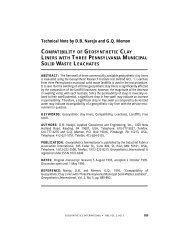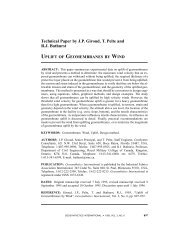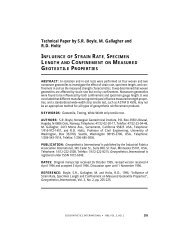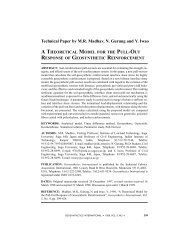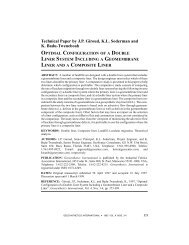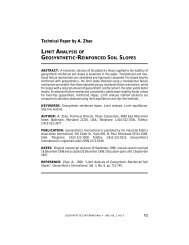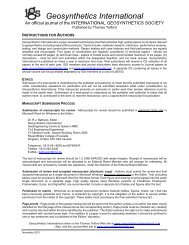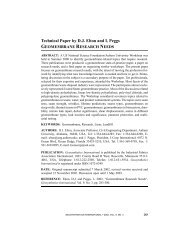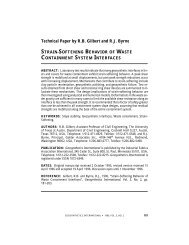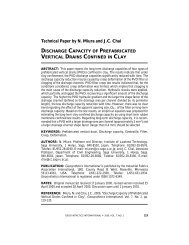Technical Paper by A. Fakher and C.J.F.P. Jones WHEN THE ...
Technical Paper by A. Fakher and C.J.F.P. Jones WHEN THE ...
Technical Paper by A. Fakher and C.J.F.P. Jones WHEN THE ...
Create successful ePaper yourself
Turn your PDF publications into a flip-book with our unique Google optimized e-Paper software.
<strong>Technical</strong> <strong>Paper</strong> <strong>by</strong> A. <strong>Fakher</strong> <strong>and</strong> C.J.F.P. <strong>Jones</strong><br />
<strong>WHEN</strong> <strong>THE</strong> BENDING STIFFNESS OF GEOSYN<strong>THE</strong>TIC<br />
REINFORCEMENT IS IMPORTANT<br />
ABSTRACT: A numerical simulation has been undertaken to model a layer of s<strong>and</strong><br />
overlaying a layer of geosynthetic reinforcement <strong>and</strong> super soft clay. Details of the<br />
model <strong>and</strong> the modelling procedures are described <strong>and</strong> the influence of the bending<br />
stiffness (flexural rigidity) of the reinforcement on the bearing capacity of super soft<br />
clay is discussed. Factors affecting the reinforcement mechanisms of geosynthetic<br />
reinforcement of super soft clay are considered.<br />
KEYWORDS: In-plane bending stiffness, Geosynthetic reinforcement, Super soft<br />
clay, Primary stage construction, Reinforced soil.<br />
AUTHORS: A. <strong>Fakher</strong>, Lecturer, Department of Civil Engineering, Tehran<br />
University, Iran, Telephone: 98/21-649-8981, Telefax: 98/21-646-1024, E-mail:<br />
afakher@ut.ac.ir; <strong>and</strong> C.J.F.P. <strong>Jones</strong>, University of Newcastle upon Tyne, Department<br />
of Civil Engineering, Drummond Building, Newcastle upon Tyne, NE1 7RU, United<br />
Kingdom, Telephone: 44/191-222-7117, Telefax: 44/191-222-6613, E-mail:<br />
c.j.f.p.jones@ncl.ac.uk.<br />
PUBLICATION: Geosynthetics International is published <strong>by</strong> the Industrial Fabrics<br />
Association International, 1801 County Road B West, Roseville, Minnesota 55113-<br />
4061, USA, Telephone: 1/612-222-2508, Telefax: 1/612-631-9334. Geosynthetics<br />
International is registered under ISSN 1072-6349.<br />
DATE: Original manuscript submitted 1 September 2001, revised version received 1<br />
November 2001, <strong>and</strong> accepted 5 November 2001. Discussion open until 1 June 2002.<br />
REFERENCE: <strong>Fakher</strong>, A. <strong>and</strong> <strong>Jones</strong>, C.J.F.P., 2001, “When the Bending Stiffness of<br />
Geosynthetic Reinforcement is Important”, Geosynthetics International, Vol. 8, No. 5,<br />
pp. 445-460.<br />
GEOSYN<strong>THE</strong>TICS INTERNATIONAL • 2001, VOL. 8, NO. 5 445
FAKHER & JONES • When Bending Stiffness of Geosynthetic Reinforcement is Important<br />
1 INTRODUCTION<br />
A clay with a very high water content behaves neither like a liquid nor like a solid, it<br />
has very little shear strength <strong>and</strong> can be termed a super soft clay. In the current paper,<br />
super soft clay is defined as a disturbed cohesive soil whose water content is higher<br />
than its liquid limit; such materials display extremely low yield stresses <strong>and</strong> represent<br />
difficult construction conditions (<strong>Fakher</strong> et al. 1999).<br />
An established technique used to enable construction on super soft clays is the<br />
introduction of a primary construction stage that is used as a working platform on<br />
which the main construction can be founded. A working platform can be produced <strong>by</strong><br />
placing a layer of geosynthetic reinforcement over the super soft clay <strong>and</strong> covering this<br />
with a layer of cohesionless fill (Figure 1) (Yamanouchi <strong>and</strong> Gotoh 1979). Although it<br />
has been demonstrated that this construction technique is successful, there is no general<br />
agreement with respect to the reinforcement mechanism <strong>and</strong> how the reinforcement<br />
improves the bearing capacity of working platforms. The current paper is aimed<br />
at providing insight into the reinforcement mechanism associated with a thin layer of<br />
cohesionless fill supported on geosynthetic reinforcement layered on the surface of<br />
super soft clays. The numerical modelling presented has been undertaken in parallel<br />
with a number of physical model studies into construction over super soft clay (<strong>Fakher</strong><br />
<strong>and</strong> <strong>Jones</strong> 1996a; <strong>Fakher</strong> <strong>and</strong> <strong>Jones</strong> 1996b; <strong>Fakher</strong> et al. 1996; Zakaria 1994). A major<br />
advantage of numerical modelling is that it enables parametric studies to be undertaken<br />
that enhance the results <strong>and</strong> findings of physical models.<br />
2 DETAILS OF <strong>THE</strong> ANALYSIS<br />
2.1 Idealisation <strong>and</strong> Boundary Conditions<br />
A representative super soft clay, overlain <strong>by</strong> a layer of s<strong>and</strong> with/without a layer of<br />
0.5 B<br />
S<strong>and</strong><br />
D<br />
Super soft clay<br />
Geogrid<br />
reinforcement<br />
10 B<br />
7 B<br />
10 B<br />
Figure 1.<br />
The geometry of the problem.<br />
446 GEOSYN<strong>THE</strong>TICS INTERNATIONAL • 2001, VOL. 8, NO. 5
FAKHER & JONES • When Bending Stiffness of Geosynthetic Reinforcement is Important<br />
reinforcement, was simulated in the current study. A surface load was applied <strong>by</strong> a<br />
rigid, rough footing of width, B, placed on the surface of the s<strong>and</strong> layer (Figure 1).<br />
The super soft clay <strong>and</strong> cohesionless fill were idealised as construction materials<br />
<strong>and</strong> the reinforcement considered to be either formed as a cable or a row of simple<br />
beam elements. The analyses were performed using the finite difference program<br />
FLAC (Itasca 1991). Details of the analysis grid <strong>and</strong> the boundary conditions used are<br />
shown in Figure 2. Because of the symmetrical geometry, each analysis was performed<br />
on half of the model.<br />
2.2 Behaviour <strong>and</strong> Mechanical Parameters of Soils<br />
Leighton Buzzard s<strong>and</strong> was used as the cohesionless soil in the parallel experimental<br />
studies on construction over super soft clays, <strong>and</strong> the properties of this material were<br />
assumed in the analytical study (<strong>Fakher</strong> <strong>and</strong> <strong>Jones</strong> 1996b). A friction angle, φ = 35°,<br />
was determined from laboratory tests, <strong>and</strong> a value for Poisson’s ratio, ν = 0.37, was<br />
chosen based upon the suggestion <strong>by</strong> Stroud (1971). A unit weight of 16 kN/m 3 was<br />
assumed for the s<strong>and</strong>. The elastic modulus, E, of s<strong>and</strong> depends upon the confining<br />
pressure <strong>and</strong> is not constant within a mass of s<strong>and</strong>. However, to simplify the analysis<br />
the elastic modulus, E, of the cohesionless fill was assumed to be 32 MPa based upon<br />
general values suggested for quartz s<strong>and</strong>s (Lambe <strong>and</strong> Whitman 1979). The values for<br />
the shear modulus, G, <strong>and</strong> the bulk modulus, K, of the cohesionless fill were derived<br />
using the following relationships:<br />
Figure 2.<br />
The grid pattern used in the current study.<br />
GEOSYN<strong>THE</strong>TICS INTERNATIONAL • 2001, VOL. 8, NO. 5 447
FAKHER & JONES • When Bending Stiffness of Geosynthetic Reinforcement is Important<br />
G<br />
E<br />
= ------------------- ( = 1.2 × 10<br />
21 ( + ν)<br />
7 Pa)<br />
(1)<br />
E<br />
K = ---------------------- ( = 4.1 × 10 (2)<br />
31 ( – 2ν)<br />
7 Pa)<br />
The elastic properties of super soft clays are difficult to measure; however, experimental<br />
studies have shown that the elastic modulus of the super soft clay is not significant<br />
in the problem (<strong>Fakher</strong> 1997). Based upon experimental findings the shear<br />
modulus <strong>and</strong> bulk modulus of the super soft clay were assumed equal to 42 <strong>and</strong> 20<br />
MPa, respectively. The shear strength of the super soft clay was assumed to be 50 Pa<br />
for the majority of the analysis, but was increased up to a value of 1,000 Pa to illustrate<br />
the influence of stronger <strong>and</strong> stiffer soil. An elastic-perfectly plastic behaviour was<br />
assumed for the soils in order to simplify the analyses.<br />
2.3 Geosynthetic Reinforcement<br />
The reinforcements were modelled in two ways in order to investigate the effects of<br />
reinforcement bending stiffness on the bearing capacity of the super soft clay:<br />
1. As cable elements, with no bending stiffness. This method is frequently used to<br />
model geosynthetic reinforcements when bending is considered unimportant. The<br />
cable elements used in the analyses were one-dimensional axial elements described<br />
in terms of cross-sectional area, elastic modulus, <strong>and</strong> yield strength of the cable.<br />
2. As beam elements with elastic bending stiffness. The beam elements used in the<br />
analyses were two-dimensional elements with three degrees of freedom at each<br />
node providing displacement in two perpendicular directions <strong>and</strong> rotation. The<br />
beam elements were described in terms of cross-sectional area, elastic modulus,<br />
second moment of area (moment of inertia), <strong>and</strong> plastic moment. The moment<br />
capacity was assumed to be infinite.<br />
The reinforcements were fixed to the line of symmetry (Figure 1). However, they<br />
were not fixed to any other vertical boundary so as not to cause an unrealistic pull-out<br />
resistance. The length of the geosynthetic reinforcement was 2 × 7B, where B is the<br />
width of the footing. In view of the low value of the shear strength of super soft clay, it<br />
was assumed that perfect adherence existed between the clay <strong>and</strong> the reinforcement.<br />
The elastic modulus <strong>and</strong> cross-sectional area of the reinforcement were assumed to<br />
be equal to 1 × 10 5 Pa <strong>and</strong> 0.0033 m 2 , respectively. The second moment of area, I, of<br />
the beam elements was assumed to be equal to 7.64 × 10 -7 m 4 . However, this value was<br />
varied from 1 × 10 - 8 to 2.15 × 10 - 6 m 4 in order to study the effect of bending stiffness,<br />
EI. The bond stiffness <strong>and</strong> the bond strength of the element-soil interface <strong>and</strong> the yield<br />
strength of the cable elements were assumed to be 3 × 10 7 N/m/m, 4.5 × 10 4 N/m, <strong>and</strong><br />
6.8 × 10 3 N, respectively for all the analyses. Details of the material properties used in<br />
the different analyses are shown in Table 1.<br />
448 GEOSYN<strong>THE</strong>TICS INTERNATIONAL • 2001, VOL. 8, NO. 5
FAKHER & JONES • When Bending Stiffness of Geosynthetic Reinforcement is Important<br />
Table 1.<br />
Variables used in the analyses.<br />
Analysis<br />
no.<br />
Second moment of<br />
area beam elements<br />
I (m 4 )<br />
Ratio of s<strong>and</strong><br />
thickness, D, <strong>and</strong><br />
footing width, B<br />
D/B<br />
Shear strength of<br />
super soft clay<br />
C (Pa)<br />
Footing<br />
width<br />
B (mm)<br />
Displacement<br />
increment<br />
(mm)<br />
Grid<br />
aperture<br />
(mm)<br />
f-20 7.64E-07 0.51 50 50.4 30 × 33<br />
f-21 7.64E-07 0.51 500 50.4 1 30 × 33<br />
f-22 7.64E-07 0.51 100 50.4 1 30 × 33<br />
f-23 7.64E-07 0.51 250 50.4 1 30 × 33<br />
f-24 7.64E-07 0.51 1000 50.4 1 30 × 33<br />
f-26 2.00E-07 0.51 50 50.4 1 30 × 33<br />
f-27 8.50E-08 0.51 50 50.4 1 30 × 33<br />
f-28 1.00E-08 0.51 50 50.4 1 30 × 33<br />
f-29 2.15E-06 0.51 50 50.4 1 30 × 33<br />
f-30 7.64E-07 0.51 50 108 2 30 × 33<br />
f-31 7.64E-07 0.51 50 252 5 30 × 33<br />
f-32 7.64E-07 0.51 50 504 10 30 × 33<br />
f-33 7.64E-07 0.51 50 1008 20 30 × 33<br />
f-40 7.64E-07 0.17 50 50.4 1 30 × 31<br />
f-42 7.64E-07 0.51 50 50.4 1 30 × 33<br />
f-44 7.64E-07 1.54 50 50.4 1 30 × 39<br />
f-45 7.64E-07 2.06 50 50.4 1 30 × 42<br />
2.4 Applied Loading<br />
At the start of the analysis, the model was switched to gravity to produce the initial<br />
stress state. Following this, a surface load was simulated <strong>by</strong> exerting successive displacement<br />
increments. The program was run for each displacement increment <strong>and</strong> an<br />
out-put file for each increment was stored; following this, the next displacement increment<br />
was exerted using the data in the stored file as the starting criteria.<br />
The displacement increment used in the analyses was found to be critical. An increment<br />
of 0.02B was found to be satisfactory for the analyses. A discussion on the effects<br />
of different displacement increments <strong>and</strong> different methods of applying load using<br />
FLAC is given <strong>by</strong> <strong>Fakher</strong> (1997).<br />
3 RESULTS AND DISCUSSION<br />
A plot of the vertical loading on the footing versus vertical displacement for each analysis<br />
is shown in Figure 3. The results show no peak bearing capacity <strong>and</strong> the selection<br />
of the point of ultimate bearing capacity is a subjective matter, which depends on engi-<br />
GEOSYN<strong>THE</strong>TICS INTERNATIONAL • 2001, VOL. 8, NO. 5 449
FAKHER & JONES • When Bending Stiffness of Geosynthetic Reinforcement is Important<br />
Vertical stress under footing (N/mm)<br />
2.4<br />
2.0<br />
1.6<br />
1.2<br />
0.8<br />
0.4<br />
0.0<br />
f-29, I = 2.15e-6 f-20, I = 7.64 e-7<br />
f-26, I = 2e-7 f-27, I = 8.5e-8<br />
f-28, I = 1e-8 f-20, no reinf.<br />
f-20, cable<br />
0 5 10 15 20 25<br />
Vertical displacement (mm)<br />
Figure 3. The influence of the reinforcement bending stiffness on the displacement of the<br />
footing under different loads (values of I are in m 4 ).<br />
neering judgement. A constant value for the modulus of elasticity, E, was chosen for<br />
the reinforcement <strong>and</strong> the bending stiffness, EI, varied <strong>by</strong> varying the second moment<br />
of area, I. The results show that the higher the bending stiffness the higher the potential<br />
bearing capacity (Figure 3). This confirmed the conclusion derived from previous unitcell<br />
shear box studies <strong>and</strong> scale-model loading tests (<strong>Fakher</strong> et al. 1996; <strong>Fakher</strong> <strong>and</strong><br />
<strong>Jones</strong> 1996b; Zakaria 1994).<br />
3.1 Effect of Bending Stiffness of the Reinforcement<br />
The effect of the reinforcement bending stiffness on the bearing load is shown in Figure<br />
4 (when the vertical displacement/load width ratio, s/B = 0.3). It can be seen that<br />
the presence of any type of reinforcement, with or without bending stiffness, has an<br />
influence.<br />
The deformed shape of a geosynthetic reinforcing material modelled as a cable or a<br />
beam element with different stiffnesses, EI, is shown in Figure 5. An explanation for<br />
the deformed shape of the reinforcement is that, as the footing moves vertically, the<br />
adjacent super soft clay moves laterally. This results in ground surface heave adjacent<br />
to the footing. The displacement of the super soft clay <strong>and</strong> the heave is influenced <strong>by</strong><br />
the in plane stiffness of the reinforcement. When the bending stiffness of the reinforcement<br />
is high the heave is reduced <strong>and</strong> distributed over a wider area.<br />
450 GEOSYN<strong>THE</strong>TICS INTERNATIONAL • 2001, VOL. 8, NO. 5
FAKHER & JONES • When Bending Stiffness of Geosynthetic Reinforcement is Important<br />
Vertical stress under footing (N/mm)<br />
0.8<br />
s /B = 0.3<br />
0.7<br />
0.6<br />
0.5<br />
Beam element<br />
No reinforcement<br />
0.4<br />
Cable element<br />
0.3<br />
0 0.04 0.08 0.12 0.16 0.2 0.24<br />
Bending stiffness, EI (Nm)<br />
Figure 4. The effect of bending stiffness of geogrid reinforcement on the bearing load<br />
(the bending stiffness is reported for one meter run <strong>and</strong> has units of Nm).<br />
Deformed geosynthetic reinforcement<br />
Y d /B<br />
0.18<br />
0.12<br />
0.06<br />
0.00<br />
-0.06<br />
-0.12<br />
-0.18<br />
-0.24<br />
-0.30<br />
f-20, cable<br />
f-28, beam, I = 1e-8<br />
f-27, beam, I = 8.5e-8<br />
f-26, beam, I = 2e-7<br />
f-20,beam, I = 7.64e-7<br />
7.0 5.4 4.2 3.4 2.7 2.2 1.7 1.2 0.7 0.2<br />
f-29, beam, I = 2.15e-6<br />
X/B<br />
Line of<br />
symmetry<br />
Figure 5. The effect of bending stiffness on the deformed shape of geogrid reinforcement<br />
at s/B = 0.3.<br />
3.2 Effect of Thickness of the S<strong>and</strong> Layer<br />
The ratio between the thickness of the s<strong>and</strong> layer, D, <strong>and</strong> the width of the footing, B,<br />
was varied from 0.17 to 2.06, <strong>and</strong> it can be seen that this has an influence on the bear-<br />
GEOSYN<strong>THE</strong>TICS INTERNATIONAL • 2001, VOL. 8, NO. 5 451
FAKHER & JONES • When Bending Stiffness of Geosynthetic Reinforcement is Important<br />
ing capacity ratio (Figure 6). The bearing capacity ratio is defined as the ratio between<br />
the bearing capacity of reinforced ground <strong>and</strong> the bearing capacity of the same case<br />
without reinforcement. When D/B is small, the increase in the bearing capacity ratio,<br />
due to bending stiffness, is significant. As the D/B ratio increases, the influence of the<br />
bending stiffness of the reinforcement diminishes.<br />
The deformed shape of geosynthetic reinforcements for different ratios of D/B is<br />
shown in Figure 7. The maximum heave of the reinforcement modelled as a cable is<br />
located close to the footing when values of D/B are small. When the value of D/B<br />
increases, the reinforcement bending stiffness has little effect on the deformed shape<br />
<strong>and</strong> the deformation of the reinforcement, modelled as a beam or a cable, are similar.<br />
3.3 Effect of Size of Footing<br />
The width of the footing, B, was varied to investigate the relative influence of the reinforcement<br />
on the behaviour of footings of different dimensions. When, B, increases,<br />
the effect of the reinforcement bending stiffness decreases sharply (Figure 8). This<br />
conforms with the findings of a dimensional analysis study on model loading tests<br />
(<strong>Fakher</strong> et al. 1996).<br />
The effect of footing width, B, on the deformed shape of the reinforcement is<br />
shown in Figure 9. The location of the point of maximum heave depends on the size of<br />
the footing when cable elements are used in the analysis. This is not apparent when<br />
beam elements are used to model the reinforcement.<br />
3.4 Effect of the Yield Stress of Clay<br />
A series of analyses were performed to investigate the influence of the shear strength of<br />
the underlying clay, C, on the bearing capacity. As expected, the bearing capacity<br />
increases when C increases. An interesting observation is that the positive effect of bend-<br />
3.5<br />
Bearing capacity ratio<br />
3.0<br />
2.5<br />
2.0<br />
1.5<br />
1.0<br />
No reinforcement<br />
Beam element<br />
Cable element<br />
I = 7.64 e-7<br />
s /B = 0.3<br />
Figure 6.<br />
0.5<br />
0.0 0.5 1.0 1.5 2.0 2.5<br />
D/B<br />
The effect of D/B on the bearing capacity ratio.<br />
452 GEOSYN<strong>THE</strong>TICS INTERNATIONAL • 2001, VOL. 8, NO. 5
FAKHER & JONES • When Bending Stiffness of Geosynthetic Reinforcement is Important<br />
Yd / B<br />
0.18<br />
0.12<br />
0.06<br />
0.00<br />
-0.06<br />
-0.12<br />
-0.18<br />
-0.24<br />
f-44, D/B = 1.54,<br />
beam, s/B = 0.3<br />
f-44, D/B = 1.54,<br />
cable, s/B = 0.3<br />
f-42, D/B = 0.51,<br />
beam, s/B = 0.3<br />
f-42, D/B = 0.51,<br />
cable, s/B = 0.3<br />
f-40, D/B = 0.17,<br />
beam, s/B = 0.3<br />
f-40, D/B = 0.17,<br />
cable, s/B = 0.3<br />
Figure 7.<br />
-0.30<br />
0 1 2 3 4 5 6 7 8<br />
X / B<br />
The effect of D/B on the deformed shape of the geosynthetic reinforcement.<br />
1.6<br />
Beam elements<br />
Bearing capacity ratio<br />
1.4<br />
1.2<br />
1.0<br />
Cable elements<br />
No reinforcement<br />
I = 7.64e-7<br />
D = 25 mm<br />
s /B = 0.3<br />
Figure 8.<br />
0.8<br />
0 200 400 600 800 1000 1200<br />
B (mm)<br />
The bearing capacity ratio at different footing sizes.<br />
ing stiffness of the reinforcement decreases when C increases (Figure 10). Thus, the reinforcement<br />
bending stiffness has little importance when the clay is not in a super soft state,<br />
<strong>and</strong> the reinforcement bending stiffness may be neglected in routine design practice.<br />
GEOSYN<strong>THE</strong>TICS INTERNATIONAL • 2001, VOL. 8, NO. 5 453
FAKHER & JONES • When Bending Stiffness of Geosynthetic Reinforcement is Important<br />
0.18<br />
0.12<br />
0.06<br />
0.00<br />
Yd / B<br />
-0.06<br />
-0.12<br />
-0.18<br />
-0.24<br />
f-20, B = 50.4 mm, beam, s/B = 0.3<br />
f-20, B = 50.4 mm, cable, s/B = 0.3<br />
f-31, B = 252 mm, beam, s/B = 0.3<br />
f-31, B = 252 mm, cable, s/B = 0.3<br />
-0.30<br />
0 1 2 3 4 5 6 7<br />
X/B<br />
Figure 9. The effect of footing size on the deformed shape of the geosynthetic<br />
reinforcement.<br />
1.5<br />
1.4<br />
Ratio = Bearing capacity from analysis with beam elements<br />
Bearing capacity from analysis with cable elements<br />
1.3<br />
Ratio<br />
1.2<br />
1.1<br />
Figure 10.<br />
1.0<br />
0 200 400 600 800 1000<br />
Shear strength of clay, C (Pa)<br />
The influence of shear strength of the underlying clay on the bearing capacity.<br />
3.5 Deformation <strong>and</strong> Displacement of the Continuum Materials<br />
The deformed shape of the finite difference grid, representing the super soft clay, the<br />
reinforcement, <strong>and</strong> the overlying s<strong>and</strong>, <strong>and</strong> the directions of the principal stresses are<br />
shown in Figure 11. The data are derived from test f-20 at s/B = 0.3 (Table 1).<br />
454 GEOSYN<strong>THE</strong>TICS INTERNATIONAL • 2001, VOL. 8, NO. 5
FAKHER & JONES • When Bending Stiffness of Geosynthetic Reinforcement is Important<br />
(a)<br />
B / 2<br />
4B<br />
3.5B<br />
(b)<br />
B / 2<br />
(c)<br />
B / 2<br />
Figure 11. The deformed shape of the grid <strong>and</strong> the principal stress directions at s/B = 0.3<br />
(analysis f-20, Table 1): (a) no reinforcement; (b) reinforcement modelled as cable<br />
elements; (c) reinforcement modelled as beam elements.<br />
The influence of the reinforcement <strong>and</strong> the reinforcement stiffness on the behaviour<br />
of the system can be seen in Figures 11b <strong>and</strong> 11c. It is apparent that, with stiff<br />
reinforcement, a shallow zone of the super soft clay is loaded.<br />
The deformed shape of the reinforcement with increased settlement is shown in<br />
Figure 12. In the case of reinforcement modelled as beam elements, heave occurs<br />
remote from the footing <strong>and</strong> increases <strong>and</strong> spreads further as s/B increases. When s/B<br />
increases from 0.1 to 0.3, the distance between the centre line <strong>and</strong> the point with the<br />
GEOSYN<strong>THE</strong>TICS INTERNATIONAL • 2001, VOL. 8, NO. 5 455
FAKHER & JONES • When Bending Stiffness of Geosynthetic Reinforcement is Important<br />
Yd / B<br />
0.18<br />
0.12<br />
0.06<br />
0.00<br />
-0.06<br />
-0.12<br />
-0.18<br />
-0.24<br />
-0.30<br />
f-20, beam, s/B = 0.3<br />
f-20, cable, s/B = 0.3<br />
f-20, beam, s/B = 0.1<br />
f-20, cable, s/B = 0.1<br />
0 1 2 3 4 5 6<br />
X / B<br />
Figure 12.<br />
settlement.<br />
The deformed shape of the geosynthetic reinforcement with increasing<br />
maximum heave increases from 1.8 B to 2.5 B for the case studied. If the bending stiffness<br />
of the geosynthetic reinforcement is neglected, heave occurs close to the footing<br />
<strong>and</strong> the horizontal location of the point of maximum heave is not influenced <strong>by</strong> an<br />
increase in s/B.<br />
3.6 Ground Surface Heave<br />
Figure 13 shows the deformed shape of the ground surface. When beam elements are<br />
used to model the geosynthetic reinforcement, a smaller heave occurs, <strong>and</strong> the location<br />
of maximum heave occurs at a distance further from the footing than the case when<br />
cable elements are used.<br />
Contours of normalised vertical displacement, Y d /B, plotted over an area of<br />
4B × 3.5B are shown in Figure 14. An interesting observation is that the maximum<br />
heave (positive values of Y d ) does not occur at the ground surface when beam elements<br />
are used (Figure 14c). The implication is that the reinforcement bending stiffness plays<br />
a significant role in preventing heave of the super soft clay from being transferred to<br />
the s<strong>and</strong> layer <strong>and</strong> ground surface.<br />
3.7 Overall Discussion<br />
When a footing overlying a layer of super soft clay settles, the clay beneath the footing<br />
moves laterally to escape toward the ground surface resulting in heave. Control of the<br />
resultant heave is a key factor to the successful construction over super soft clay <strong>and</strong> in<br />
the bearing capacity mechanism. The reinforcement bending stiffness plays a significant<br />
role in preventing the heave of the super soft clay being transferred to the s<strong>and</strong><br />
456 GEOSYN<strong>THE</strong>TICS INTERNATIONAL • 2001, VOL. 8, NO. 5
FAKHER & JONES • When Bending Stiffness of Geosynthetic Reinforcement is Important<br />
0.15<br />
0.10<br />
0.05<br />
Figure 13.<br />
Yd / B<br />
0.00<br />
-0.05<br />
-0.10<br />
f-20, no-reinf., s/B = 0.3<br />
-0.15<br />
f-20, beam, s/B = 0.3<br />
-0.20<br />
-0.25<br />
f-20, cable, s/B = 0.2<br />
-0.30<br />
0 2 4 6 8 10<br />
X / B<br />
The deformed shape of the ground surface.<br />
layer. When the bending stiffness of the reinforcement is high, the heave is reduced<br />
<strong>and</strong> distributed over a wider area. It can be concluded that the use of geosynthetic reinforcement<br />
having a stiff three-dimensional structure, such as a geocell, is beneficial.<br />
The structural behaviour of the geosynthetic in this situation can be likened to a<br />
plate that has bending stiffness (flexural rigidity) <strong>and</strong> tensile stiffness. The plate-type<br />
behaviour of reinforcement, with bending stiffness, overlaying super soft clay provides<br />
more than a large displacement mechanism, such as a membrane-type support<br />
system (Burd 1995). The plate-type behaviour starts with a small vertical deflection of<br />
the reinforcement <strong>and</strong> distributes the heave of the ground surface over a wider area as<br />
the vertical deflection of the footing increases. It is seen that as the size of the footing<br />
increases, the influence of the bending stiffness of the reinforcement decreases<br />
sharply; this confirms the plate-type behaviour of the mechanism.<br />
When a fill is being spread on the geosynthetic overlying the super soft clay, the<br />
surface layer of the clay tends to move laterally, pushed out <strong>by</strong> the spreading layers of<br />
soil. Consequently, a tensile force is developed in the geosynthetic reinforcement due<br />
to lateral movement of the soil. This tensile force needs to be sustained <strong>by</strong> the anchorage<br />
of the reinforcement; this is provided <strong>by</strong> the pull out resistance of the reinforcement<br />
at the interface of the s<strong>and</strong> <strong>and</strong> clay. As the reinforcement tensile stiffness<br />
increases, the required pull out displacement to mobilise the maximum pull out resistance<br />
decreases. Hence, a geosynthetic reinforcement with a high tensile stiffness (as<br />
opposed to high bending stiffness) provides a better anchorage in the soils resulting in<br />
an increase in the bearing capacity.<br />
4 CONCLUSIONS<br />
The bending stiffness of geosynthetic reinforcement is neglected in most design prac-<br />
GEOSYN<strong>THE</strong>TICS INTERNATIONAL • 2001, VOL. 8, NO. 5 457
FAKHER & JONES • When Bending Stiffness of Geosynthetic Reinforcement is Important<br />
(a)<br />
-0.3<br />
-0.2<br />
B / 2<br />
-0.05<br />
+0.1<br />
+0.05<br />
Y d / B = 0<br />
(b)<br />
-0.3<br />
-0.1<br />
-0.05<br />
+0.1<br />
+0.05<br />
Reinforcement<br />
Y d / B = 0<br />
(c)<br />
-0.3<br />
+0.1<br />
Reinforcement<br />
-0.1<br />
-0.05<br />
+0.05<br />
Y d / B = 0<br />
Figure 14. Contours of normalised vertical displacement, Y d /B : (a) no reinforcement;<br />
(b) cable elements used to model the reinforcement; (c) beam elements used to model the<br />
reinforcement.<br />
458 GEOSYN<strong>THE</strong>TICS INTERNATIONAL • 2001, VOL. 8, NO. 5
FAKHER & JONES • When Bending Stiffness of Geosynthetic Reinforcement is Important<br />
tice, but it should be considered in the design of earthworks over super soft clay. The<br />
current study suggests that the structural behaviour of the reinforcement over super<br />
soft clay is like a plate supported <strong>by</strong> the vertical reaction force from the clay. If the<br />
plate is anchored horizontally, it will present a high resistance to the vertical load. The<br />
effect of the reinforcement pull-out resistance is to provide a horizontal restraint for<br />
the plate. The following conclusions associated with the influence of the reinforcement<br />
bending stiffness resulted from the current study:<br />
1. The structural behaviour of the geosynthetic reinforcement with bending stiffness<br />
used as a primary construction stage over super soft clays is like a stiff plate.<br />
2. The higher the reinforcement bending stiffness, the higher the bearing capacity of<br />
the system.<br />
3. The use of reinforcement with high bending stiffness reduces the heave of the surface<br />
which is distributed over a wider area.<br />
4. With very stiff (in bending) reinforcement, the maximum heave does not occur at<br />
the ground surface.<br />
The relative importance of the reinforcement bending stiffness depends on the following<br />
factors:<br />
• When the D/B ratio is small, the increase of the bearing capacity ratio due to bending<br />
stiffness is significant.<br />
• When the footing width B increases, the effect of bending stiffness decreases<br />
sharply.<br />
• The reinforcement bending stiffness is not important when the underlying clay is<br />
not in a super soft state.<br />
REFERENCES<br />
Burd, H.J., 1995, “Analysis of Membrane Action in Reinforced Unpaved Roads”,<br />
Canadian Geotechnical Journal, Vol. 32, No. 6, pp. 946-956.<br />
<strong>Fakher</strong>, A., 1997, “Laboratory <strong>and</strong> Analytical Investigation into Construction Over<br />
Super Soft Clays”, Ph.D. Thesis, University of Newcastle Upon Tyne, United<br />
Kingdom, 161 p.<br />
<strong>Fakher</strong>, A. <strong>and</strong> <strong>Jones</strong>, C.J.F.P., 1996a, “L<strong>and</strong> Reclamation Using Super Soft Clay”,<br />
Proceedings of the Second International Conference on Soft Soil Engineering,<br />
Hohai University Press, Vol. 2, Nanjang, China, pp. 775-780.<br />
<strong>Fakher</strong>, A. <strong>and</strong> <strong>Jones</strong>, C.J.F.P., 1996b, “A New Unit Cell to Study the Deformation<br />
Mechanism of Super Soft Clay Overlaid <strong>by</strong> Geogrid <strong>and</strong> S<strong>and</strong>”, Geosynthetics<br />
International, Vol. 3, No. 3, pp. 349-367.<br />
<strong>Fakher</strong>, A., <strong>Jones</strong>, C.J.F.P., <strong>and</strong> Zakaria, N.-A.B., 1996, “The Influence of Dimensional<br />
Analysis on the Interpretation of Model Loading Tests of Reinforced Ground”,<br />
Earth Reinforcement, Ochiai, H., Yasufuku, N., Omine, K., Editors, Balkema, Vol.<br />
1, Proceedings of the International Symposium on Earth Reinforcement, IS<br />
GEOSYN<strong>THE</strong>TICS INTERNATIONAL • 2001, VOL. 8, NO. 5 459
FAKHER & JONES • When Bending Stiffness of Geosynthetic Reinforcement is Important<br />
Kyushu '96, Fukuoka, Japan, November 1996, pp. 585-589<br />
<strong>Fakher</strong>, A., <strong>Jones</strong>, C.J.F.P., <strong>and</strong> Clarke, B.G., 1999, “Yield Stress of Super Soft Clays”,<br />
Journal of Geotechnical <strong>and</strong> Geoenvironmental Engineering, Vol. 25, No. 6, pp.<br />
499-509.<br />
Itasca, 1991, “Fast Lagrangian Analysis of Continua, Ver. 3.03.”, Minneapolis, Minnesota,<br />
USA, Itasca Consulting Group, Inc.<br />
Lambe, T.W. <strong>and</strong> Whitman, R.V., 1979, “Soil Mechanics”, John Wiley & Sons, New<br />
York, New York, USA, 553 p.<br />
Stroud, M.A., 1971, “The Behaviour of S<strong>and</strong> at Low Stress Levels in the Simple Shear<br />
Apparatus”, Ph.D. Thesis, University of Cambridge, United Kingdom, 163 p.<br />
Yamanouchi, T. <strong>and</strong> Gotoh, K., 1979, “A Proposed Practical Formula of Bearing<br />
Capacity for Earthwork Method on Soft Clay Ground Using a Resinous Mesh”,<br />
Technology Reports of Kyushu University, Vol. 52, No. 3, pp. 201-207. (in Japanese)<br />
Zakaria, N.A., 1994, “Construction on Supersoft Soils Using Geogrids”, Ph.D. Thesis,<br />
University of Newcastle Upon Tyne, United Kingdom, 230 p.<br />
NOTATIONS<br />
Basic SI units are given in parentheses.<br />
B = width of footing (m)<br />
C = shear strength of clay (Pa)<br />
D = thickness of s<strong>and</strong> layer overlying reinforcement (m)<br />
E = elastic modulus (Pa)<br />
G = shear modulus (Pa)<br />
I = second moment of area of reinforcement (m 4 )<br />
K = bulk modulus (Pa)<br />
s = settlement of footing (m)<br />
X = distance from centre line of footing (m)<br />
Y d = vertical displacement of the soil continuum (m)<br />
ν = Poisson’s ratio (dimensionless)<br />
φ = friction angle of s<strong>and</strong> (°)<br />
460 GEOSYN<strong>THE</strong>TICS INTERNATIONAL • 2001, VOL. 8, NO. 5



